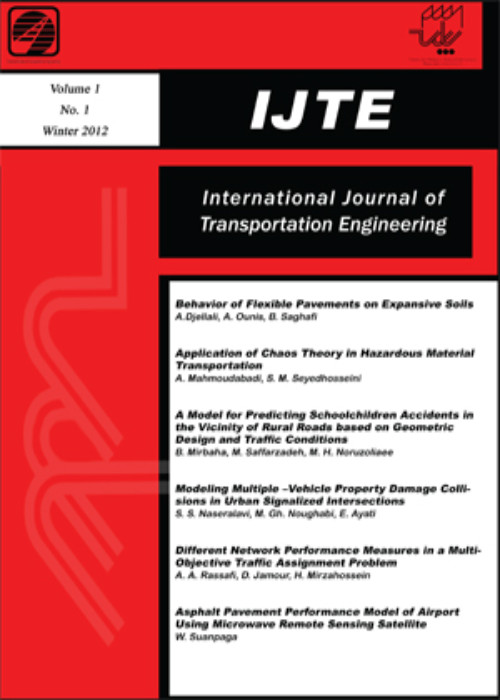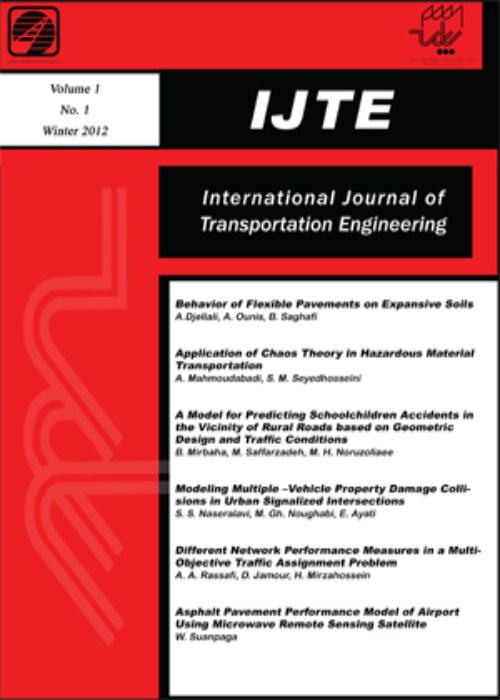فهرست مطالب

International Journal of Transportation Engineering
Volume:10 Issue: 3, Winter 2023
- تاریخ انتشار: 1401/10/11
- تعداد عناوین: 6
-
-
Pages 1055-1068Problems such as flights sequences, flights emergency positions, hijacking, airport controlled space management, and Free Flight are problems that the Air Traffic Management (ATM) are faced with it. Managing a large volume of flights data and their correct interpretation plays a key role in the prevention of air accidents, human errors, and flight interactions. The agent-based systems and ontology are tools that together have attributes such as autonomy, learning, and cooperation to solve ATM's problems. This research proposed a new ontology-based multi-agent system for air traffic management. The design of air agents has been done on the architectural basis of BDI. This model contains five main modules that were designed under Multi-agent Software Engineering (MaSE) methodology in AgentTool tools. Methontology methodology was exploited for the engineering of the ontology of agents and the implementation process was carried out using the Protégé software. The hybrid model ATM ontology-based multi-agent system (ATM-onto-mas) has been implemented with Java Agent Development Framework (JADE). The actual flight data of Mashhad Airport, Iran used to evaluate and test this model. Terminal control area (TMA) of Mashhad Airport was designed and simulated in an ATCsim simulator based on real data. The obtained results of the ATM-onto-mas system in a simulated environment indicate improvement in the evaluated parameters Compared with other methods.Keywords: Air Traffic Management, BDI Architecture, Agent-based, MaSE Methodology, ontology, Methontology methodology
-
Pages 1069-1088Understanding travel behavior is one of the most critical challenges in transportation planning. Planners can gain profound insights into travel behavior by exploring people’s perceptions and attitudes. Qualitative research as an independent approach or in a combination of a quantitative research can provide a deep understanding of people’s perceptions in transportation. This study used both qualitative and quantitative techniques to inspect citizens’ perceptions towards travel behavior. The interview results of the qualitative approach indicated that environmental concerns were mainly rooted in spiritual ethics. In addition, the respondents identified comfort, time, safety, and environmental concerns as the critical determinants in travel mode choice. The characteristics of individuals and transportation alternatives as well as environmental concerns were considered to affect mode choice in the quantitative study. The results, extracted from an Integrated Choice and Latent Variable (ICLV) model, showed that environmental concerns influenced people to choose public transportation. Furthermore, the findings indicated that young and middle-aged people preferred to use public transportation. Still, the preference was about quadruple for the middle-aged group.Keywords: Travel Mode, Perception, mode choice, Environmental Concerns
-
Pages 1089-1102Accidents are a major problem that claim the lives of many people in the world each year. Fatalities and severe injuries could leave adverse and irreversible impacts on public health and economic prospects. A review of the variables affecting the severity of crash injuries can help reduce fatal accidents. However, a detailed prediction of fatal crashes as a smaller-data class than other classes is seen as a challenge. This study uses three robust machine learning such as Bayesian classifier, random forest, and support vector machine techniques. First, three imbalanced data prediction models were developed, suggesting they could not differentiate fatal data from injury data. To address this problem, three random, k-means clustering, meta-heuristic algorithms clustering techniques were used to balance the data. It should be noted that the genetic algorithm performed better than the particles swarm. Models developed by intelligent optimization methods, k-means clustering, and random methods were found to be more accurate, respectively. These criteria helped evaluate the models developed, which yielded the best model. The support vector machine method for genetic clustering-balanced data could predict fatal, and injury crashes with a 0.96% accuracy, becoming the best model. Finally, sensitivity analysis was performed on the best model, indicating that the highway, horizontal curves, and head-on variables contributed to fatal accidents.Keywords: Genetic Algorithm, particles swarm, optimization, crashes, Machine Learning
-
Pages 1103-1119Among the many goals of global plans, one can refer to the development and implementation of sustainable road safety strategies and programs which can lead to an ambitious but feasible goal of reducing road fatalities by monitoring road safety performance indicators. With global goals in mind, this study attempts to provide a rational framework for comparing several mathematical models for achieving national-level road safety targets in Iran and among a number of developing countries and emerging economies. The main purpose of this paper is to develop a multi-criteria decision making model for analyzing and selecting the best composite indicator from the results of several previous studies in this field over the fifteen countries. For this purpose, the PROMETHEE method was used to analyze the robustness of the results of four methods. These four methods are simple ranking by fatality rates, Success Indicators using data envelopment analysis by a two-objective nonlinear programming model, integration of Structural Equation Modeling and Data Envelopment Analysis (SEM-DEA method), and the outranking method of ELECTRE that were used simultaneously in a study to analyze road safety performance indicators in the same 15 countries. By applying the preference function used in this study, the ELECTRE method has presented higher robust results. Interventions that should be emphasized in Iran in priority order are the development of vehicle safety, the improvement of the road safety management structure and the development of post-crash response.Keywords: Outranking methods, Composite road safety performance indicators, Data Envelopment Analysis, Road Safety Pillars
-
Pages 1121-1137Many projects fail to achieve their expected benefit, cost, scope, and time objectives because their related risks and uncertainties reduce the accuracy in properly estimating the objectives and, thus, reduce the project efficiency. Since risks are accompanied with uncertainties and lack of reliability, many of them are irremovable in construction projects and their proper management is the only way to prevent damage. Hence, before a project starts, it is quite necessary that its risks should be identified, quantified, and evaluated to prevent them to occur using proper strategies and prioritization methods. As road construction projects involve numerous activities, and unexpected factors affect their final time and cost, the present study has identified their related risks by reviewing the literature and asking the experts’ opinions, prioritized them by the traditional Failure Mode and Effect Analysis (FMEA), selected the critical ones, and used the Monte Carlo simulation technique to quantitatively analyze their effects on the project time/cost scheduling. Also, sensitivity analysis was done by varying the percent occurrence probability of risks to evaluate determine the relationship between the percentage of probability of occurrence of risks and time and cost of road projects. Finally, responses to identified risk provided in order to reduce their effects on the time and cost of road construction projects.Keywords: Risk Analysis, Road Project, quantitative, qualitative, Response
-
Pages 1139-1162The present study aims to identify the inconsistencies resulting from the interferences between the geometric features of the highway, access points and traffic control devices by extracting the frequent association rules and discovering the patterns that contribute to the recurrent crashes. A case study was conducted on a 117-kilometer urban highway around Mashhad. The data for five years of crashes were procured from the corresponding authorities and placed on the network under a geo spatial software environment. Then, the all features of the highway were collected. The trip times between the nodes and existing features were calculated via coding based on the data obtained from one of the route planning software. The operating speed was subsequently estimated. According to the obtained databank and considering the geometric features of the road (horizontal and vertical), the access points, road width, operating speed and position of the traffic control devices (signs and speed control camera), efforts were made to divide the road to the sections. Allocating the crash data to the sections and using the FP-Growth Algorithm, the frequent rules affecting the recurrent crash occurrences were extracted. The results showed that there are different combinations of the geometric road-related factors such as flat-straight alignment and horizontal curve along with cases like right-hand exit, consecutive entrance and exit, and reduced road width in addition to the presence of speed control camera and advanced direction signs on the highway sections together cause inconsistencies like the recurrent crash occurrences.Keywords: Association rules, crash analysis, Data-mining, Geo spatial system, inconsistency


